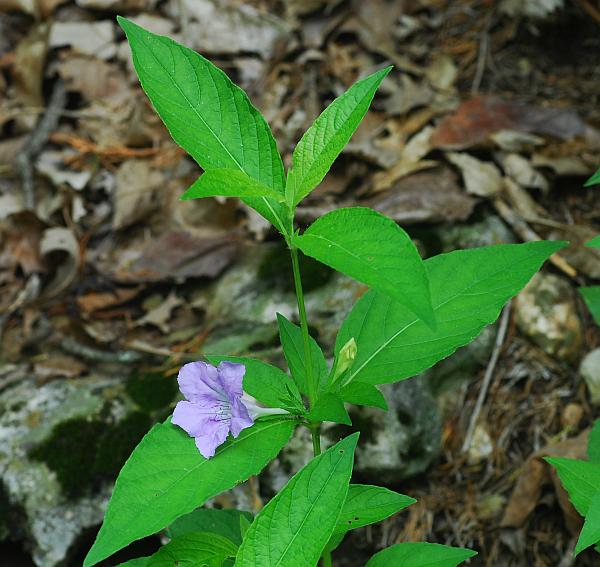Ruellia strepens L.
Wild Petunia

Native
CC = 3
CW = 0
MOC = 70
© SRTurner
Ruellia strepens L.Wild Petunia | |
 |
Native CC = 3 CW = 0 MOC = 70 |
© SRTurner |
|
Family - Acanthaceae Habit - Perennial forb. Stems - Ascending to erect, to 1.0 m, unbranched or branched, glabrous or more commonly minutely hairy in 2 narrow, longitudinal bands on opposite sides, the hairs 0.1-0.2 mm long, appearing crinkled.
Leaves - Opposite, simple, petiolate. Petioles 3-20 mm long. Blades of main stem leaves 2-16 cm long, ovate or broadly lanceolate to elliptic or less commonly obovate, mostly tapered to a sharp point at the tip, tapered or less commonly rounded at the base, hairy on both sides and minutely hairy along the margins.
Inflorescences - Flower clusters in the axils of main stem leaves and usually also at and near the tip of axillary branches (inflorescence stalks) to 8 cm long, the flowers subtended by hairy lanceolate to obovate leaflike bracts 10-40 mm long.
Flowers - Calyx lobes 9-20 mm long, 2-4 mm wide, narrowly lanceolate, sparsely to less commonly densely hairy on the back (especially along the midnerve), with a fringe of white hairs 1-2 mm long along the margins. Corollas zygomorphic, 5-lobed, 3-7 cm long, 2-4 cm wide, lavender or bluish. Corolla tube with a whitened, constricted portion at base. Stamens 4, didynamous, adnate at the apex of the constricted portion of the corolla tube. Filaments white, 1.3 cm long, sparsely pubescent at the base, glabrous above. Anthers yellow, 3 mm long. Style to 4 cm long, sparsely pubescent below, white. Stigma 2-lobed, curled. Ovary superior, with some glandular pubescence at apex near style, 4 mm long, 1.3 mm in diameter, conic, 2-locular.
Fruits - Capsules 10-20 mm long, brown, glabrous, explosively dehiscent. Flowering - May - October. Habitat - Bottomland and mesic forests, streambanks, pond margins, pastures, moist roadsides, railroads. Origin - Native to the U.S. Lookalikes - R. pedunculata. Other info. - This pretty species is common across most of Missouri. Beyond Missouri its range comprises a patch mostly occupying the U.S. central Midwest, extending in more scattered fashion southward into Gulf Coast states. The plant is easily recognized by its large, petunia-like lavender flowers and deep green, opposite leaves. It is distinguished from Missouri's other two members of the genus by its relatively wide calyx lobes. On the lookalike species, these are very narrow, almost bristlelike. Although the corolla looks regular, it is typically zygomorphic, with one petal being slightly larger than the other four. The flowers of this species only last for one day but the plant produces several flowers while in bloom. Photographs taken at Weldon Spring Conservation Area, St. Charles County, MO, 10-6-2007 and 6-8-2014, and Young Conservation Area, Jefferson County, MO, 7-27-2013 (SRTurner). |